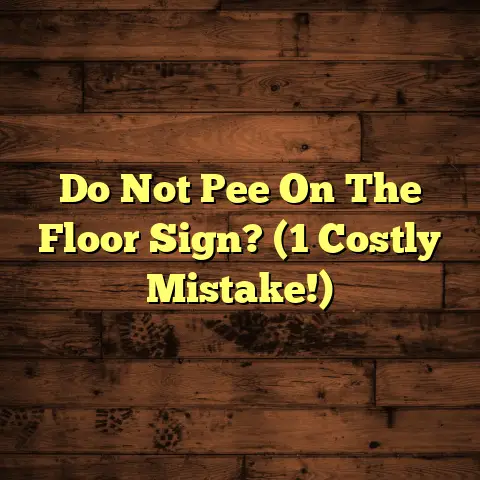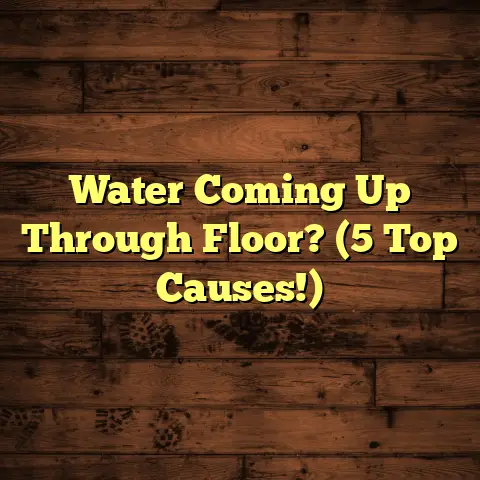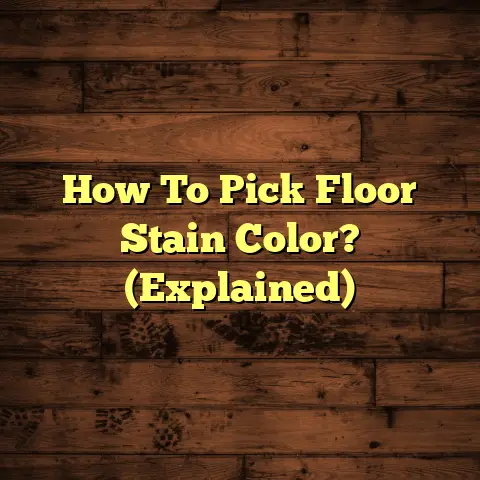Concrete Floor Finishes: 3 Types Explained? (Under 1 Hour!)
One of the most versatile and durable options out there is concrete flooring. But let’s be honest, plain concrete can be a bit, well, plain. That’s where concrete floor finishes come in.
They’re the secret sauce that takes a simple concrete slab from drab to fab, while also adding protection and longevity. Think of it like this: you wouldn’t leave your car without a paint job, right? Same goes for concrete floors!
Choosing the right finish can feel overwhelming, but don’t worry, I’m here to break it down for you. We’ll dive into three popular types: polished, stained, and epoxy. By the end of this, you’ll be armed with the knowledge to make the best choice for your project. Let’s get started!
Section 1: Understanding Concrete Flooring
So, what exactly is concrete flooring? Simply put, it’s a floor made from, you guessed it, concrete! It’s a mixture of cement, water, and aggregates (like sand and gravel). You’ll find it everywhere, from sleek modern homes to bustling warehouses.
Common Uses:
- Residential: Basements, kitchens, living areas, garages, patios.
- Commercial: Retail stores, restaurants, offices, warehouses, showrooms.
Now, why choose concrete in the first place? Well, it’s got a lot going for it. Here’s a few advantages:
- Durability: Concrete is tough! It can withstand heavy foot traffic, equipment, and general wear and tear. I’ve seen concrete floors last for decades with proper care.
- Low Maintenance: Once sealed or finished, concrete is easy to clean and maintain. A simple sweep and occasional mop usually does the trick.
- Cost-Effectiveness: Compared to some other flooring options like hardwood or tile, concrete can be a more budget-friendly choice, especially if you’re starting with an existing slab. According to a 2023 report by HomeAdvisor, the average cost to install concrete flooring ranges from $3 to $8 per square foot, which is often less than the cost of hardwood or tile.
But here’s the thing: raw concrete isn’t the most attractive or functional surface. It’s porous, which means it can absorb stains and moisture. It can also be dusty and rough. That’s why concrete floor finishes are so important.
Think of them as the finishing touch that unlocks concrete’s full potential. They enhance its durability, protect it from damage, and transform its appearance.
Section 2: The Importance of Choosing the Right Finish
Choosing the right concrete floor finish is like picking the perfect frame for a masterpiece. It’s not just about aesthetics; it’s about protecting your investment and creating a space that works for your needs.
Let’s talk about longevity. A good finish acts as a shield against the daily grind. It protects the concrete from scratches, stains, and moisture damage. Without a finish, your floor is much more vulnerable to wear and tear, which can lead to costly repairs down the road.
And then there’s the look and feel of your space. The finish you choose can dramatically impact the ambiance and design. Do you want a sleek, modern vibe? A rustic, industrial feel? Or something warm and inviting? The right finish can help you achieve your vision.
For example, a polished concrete floor can create a bright and airy atmosphere, while a stained concrete floor can add warmth and character. Epoxy coatings can even be customized with metallic pigments or decorative flakes for a truly unique look.
Now, let’s get to the main event: the three primary types of concrete floor finishes we’ll be exploring in detail:
- Polished Concrete: A sleek, modern option created by grinding and polishing the concrete surface.
- Stained Concrete: A decorative finish that uses stains to add color and depth to the concrete.
- Epoxy Coatings: A durable and versatile coating that provides a seamless, chemical-resistant surface.
We’ll dive deep into each of these, covering their benefits, drawbacks, ideal applications, and maintenance requirements. By the end, you’ll be well-equipped to choose the perfect finish for your concrete floor!
Section 3: Polished Concrete Finish
Alright, let’s kick things off with polished concrete. This finish has become incredibly popular in recent years, and for good reason. It’s sleek, durable, and surprisingly low-maintenance.
So, what exactly is polished concrete? It’s created through a multi-step process of grinding and polishing the concrete surface using specialized equipment and diamond-impregnated tools. Think of it like sanding wood, but on a much larger scale.
The process typically involves:
- Grinding: Removing the top layer of concrete to expose the aggregate (the sand and gravel).
- Honing: Smoothing the surface with progressively finer grits of diamond tools.
- Polishing: Achieving the desired level of shine with even finer grits and polishing compounds.
- Sealing (Optional): Applying a concrete sealer to further protect the surface and enhance its sheen.
Benefits of Polished Concrete:
- Sleek Appearance: Polished concrete has a modern, sophisticated look that can complement a variety of design styles. It reflects light beautifully, making spaces feel brighter and more open.
- Ease of Maintenance: This is a big one! Polished concrete is incredibly easy to clean. A simple sweep and occasional damp mop are usually all it takes to keep it looking its best.
- Resistance to Stains and Moisture: The polishing process densifies the concrete surface, making it less porous and more resistant to stains and moisture.
- Durability: Polished concrete is incredibly durable and can withstand heavy foot traffic and wear and tear. I’ve seen properly maintained polished concrete floors last for decades.
- Eco-Friendly: Polishing existing concrete is a sustainable flooring option that reduces the need for new materials.
Ideal Applications:
- Residential: Modern homes, open-concept living areas, basements, kitchens.
- Commercial: Retail stores, showrooms, restaurants, offices, warehouses.
I remember working on a project for a local boutique a few years back. The owner wanted a modern, minimalist look that was also easy to maintain. We recommended polished concrete, and she was thrilled with the results. The floor looked stunning, and she loved how easy it was to clean up spills and keep the space looking fresh.
Potential Drawbacks:
- Initial Costs: Polished concrete can have a higher upfront cost compared to some other flooring options, due to the specialized equipment and labor involved. According to a 2023 estimate from ConcreteNetwork.com, polished concrete costs from $3 to $15 per square foot.
- Professional Installation: Polishing concrete is not a DIY project. It requires specialized equipment and expertise to achieve a professional-looking finish.
- Can Be Slippery When Wet: While polished concrete is generally slip-resistant, it can become slippery when wet. Adding a non-slip additive to the sealer can help mitigate this.
- Noise: Polished concrete can be a bit noisy, especially in large, open spaces. Adding rugs or other soft surfaces can help absorb sound.
Overall, polished concrete is a fantastic option for those seeking a durable, low-maintenance, and aesthetically pleasing flooring solution. Just be sure to factor in the initial costs and hire a qualified professional for the installation.
Section 4: Stained Concrete Finish
Now, let’s move on to stained concrete. This finish is all about adding color and character to your concrete floor. It’s a great way to achieve a unique, custom look that reflects your personal style.
So, what is stained concrete? It involves applying a stain to the concrete surface to create a permanent color change. Unlike paint, which sits on top of the concrete, stain penetrates the surface and reacts chemically with the concrete, creating a translucent, varied color effect.
There are two main types of concrete stains:
- Acid-Based Stains: These stains contain metallic salts in an acid solution. They react chemically with the concrete, creating a mottled, variegated color effect. Acid-based stains are known for their durability and resistance to fading.
- Water-Based Stains: These stains use pigments to color the concrete. They offer a wider range of colors than acid-based stains and are generally more environmentally friendly. Water-based stains are easier to apply and control, but may not be as durable as acid-based stains.
Aesthetic Advantages of Stained Concrete:
- Variety of Colors and Effects: Stained concrete offers a wide range of color options, from earthy tones to bold, vibrant hues. You can also create various effects, such as faux marble, leather, or wood grain.
- Unique, Custom Look: Because the stain reacts differently with each concrete slab, no two stained concrete floors are exactly alike. This creates a unique, custom look that adds character and personality to your space.
- Enhanced Depth and Dimension: Stained concrete adds depth and dimension to the floor, creating a more visually interesting surface.
- Cost-Effective: Staining concrete is often more affordable than other decorative flooring options, such as tile or hardwood.
Suitable Environments:
- Residential: Living rooms, kitchens, bathrooms, basements, patios.
- Commercial: Retail stores, restaurants, offices, lobbies.
I’ve used stained concrete in countless projects, and I’m always amazed at the transformations. I remember one project where we stained a concrete patio to resemble natural stone. The homeowners were thrilled with the results. It looked like they had spent a fortune on high-end stonework, but it was actually just stained concrete!
Maintenance and Durability:
- Maintenance: Stained concrete is relatively easy to maintain. Regular sweeping and mopping are usually all that’s needed. Applying a sealer every few years will help protect the stain and keep it looking its best.
- Durability: Stained concrete is durable, but it’s not as resistant to scratches and abrasion as polished concrete or epoxy coatings. Using rugs and mats in high-traffic areas can help protect the stain from wear and tear.
Compared to other finishes:
- Polished Concrete: Polished concrete is more durable and resistant to scratches and stains than stained concrete, but it doesn’t offer the same level of color and design options.
- Epoxy Coatings: Epoxy coatings are more resistant to chemicals and abrasion than stained concrete, but they can be more expensive and require more extensive preparation.
In conclusion, stained concrete is a great option for those seeking a decorative and affordable flooring solution. It offers a wide range of color and design options, allowing you to create a unique and personalized space. Just be sure to consider its durability compared to other finishes and take steps to protect it from wear and tear.
Section 5: Epoxy Coating Finish
Last but not least, let’s talk about epoxy coatings. This finish is known for its durability, chemical resistance, and versatility. It’s a popular choice for both residential and commercial applications where a tough, seamless surface is needed.
So, what is an epoxy coating? It’s a thermosetting polymer that is applied as a liquid and then hardens into a durable, protective coating. Epoxy coatings are typically two-part systems, consisting of a resin and a hardener, that are mixed together before application.
Application Process:
- Surface Preparation: The concrete surface must be clean, dry, and free of any contaminants, such as oil, grease, or dust. This may involve grinding, shot blasting, or acid etching.
- Priming (Optional): A primer may be applied to improve adhesion and prevent the epoxy from absorbing into the concrete.
- Mixing: The resin and hardener are mixed together according to the manufacturer’s instructions.
- Application: The epoxy coating is applied using a roller, brush, or squeegee. Multiple coats may be needed to achieve the desired thickness and coverage.
- Curing: The epoxy coating is allowed to cure according to the manufacturer’s instructions. This can take anywhere from a few hours to several days.
Benefits of Epoxy Coatings:
- High Resistance to Chemicals: Epoxy coatings are highly resistant to chemicals, solvents, and acids, making them ideal for industrial and commercial environments where spills are common.
- Seamless Surface: Epoxy coatings create a seamless, non-porous surface that is easy to clean and sanitize.
- Durability: Epoxy coatings are incredibly durable and can withstand heavy foot traffic, equipment, and impact.
- Customizable: Epoxy coatings can be customized with various colors, textures, and decorative elements, such as metallic pigments, glitter, or decorative flakes.
- Enhanced Safety: Epoxy coatings can be formulated with anti-slip additives to improve traction and reduce the risk of slips and falls.
How Epoxy Enhances Safety and Visual Appeal:
- Anti-Slip Options: Adding a non-slip additive to the epoxy coating creates a textured surface that improves traction and reduces the risk of slips and falls. This is especially important in areas where the floor may be wet or oily.
- Metallic Finishes: Metallic pigments can be added to the epoxy coating to create a stunning, three-dimensional effect. Metallic epoxy floors are popular in showrooms, restaurants, and high-end homes.
- Decorative Flakes: Decorative flakes, such as mica flakes or vinyl chips, can be broadcast into the wet epoxy coating to add color, texture, and visual interest. This is a great way to create a unique and personalized floor.
Beneficial Scenarios:
- Garages: Epoxy coatings are a popular choice for garage floors because they are resistant to oil, gasoline, and other automotive fluids. They also create a durable, easy-to-clean surface that can withstand heavy use.
- Warehouses: Epoxy coatings are ideal for warehouses because they can withstand heavy equipment, forklift traffic, and chemical spills.
- Industrial Spaces: Epoxy coatings are used in a variety of industrial settings, such as manufacturing plants, laboratories, and food processing facilities, because they are resistant to chemicals, abrasion, and impact.
- Hospitals and Healthcare Facilities: Epoxy coatings are used in hospitals and healthcare facilities because they are seamless, non-porous, and easy to sanitize.
I’ve seen epoxy coatings transform some pretty rough-looking spaces. I remember working on a project for a local auto repair shop. The garage floor was stained, cracked, and covered in oil. We applied an epoxy coating, and it completely transformed the space. The floor was now clean, durable, and chemical-resistant. The shop owner was amazed at the difference.
In summary, epoxy coatings are a versatile and durable flooring solution that offers a wide range of benefits. They are resistant to chemicals, abrasion, and impact, and they can be customized with various colors, textures, and decorative elements. If you need a tough, seamless surface that can withstand heavy use, epoxy coatings are an excellent choice.
Section 6: Conclusion
Wow, we’ve covered a lot of ground! Let’s recap the key takeaways from our exploration of concrete floor finishes:
- Polished Concrete: Sleek, modern, and low-maintenance. Ideal for those seeking a durable and aesthetically pleasing surface.
- Stained Concrete: Decorative and affordable. Offers a wide range of color and design options. Great for adding character and personality to your space.
- Epoxy Coatings: Durable, chemical-resistant, and versatile. Perfect for high-traffic areas and industrial environments.
Choosing the right finish for your concrete floor is a big decision. It’s important to consider your specific needs, environmental factors, and aesthetic preferences.
Think about the following:
- Traffic: How much foot traffic will the floor be subjected to?
- Environment: Will the floor be exposed to chemicals, moisture, or extreme temperatures?
- Aesthetics: What look and feel do you want to achieve?
- Budget: How much are you willing to spend on the finish?
Weigh the pros and cons of each finish in relation to your unique flooring challenges. Consider the long-term costs of maintenance and repairs. And don’t be afraid to consult with flooring professionals to get expert advice.
Ultimately, the best concrete floor finish is the one that meets your specific needs and helps you create a space that you love.
Call to Action:
Ready to take the next step?
- Explore Your Options: Browse online resources, visit showrooms, and gather inspiration.
- Consult with Flooring Professionals: Get expert advice and recommendations tailored to your specific needs.
- Consider Your Specific Requirements: Think about your budget, lifestyle, and aesthetic preferences.
Choosing the right concrete floor finish is an investment that will pay off for years to come. With a little research and planning, you can transform your concrete floor into a beautiful, durable, and functional surface that enhances your space and adds value to your property. Good luck!





